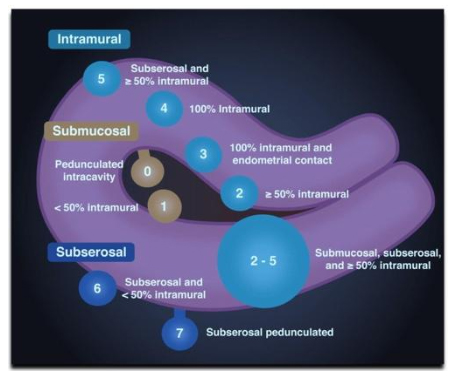Need Help?
We are here to help.
We care for each one who come to us with hope in their hearts.


Uterine Fibroids are muscular growth of the uterus that usually occur in child bearing years. They vary in size from seedlings to bulky masses that can distort and enlarge the uterus. The exact cause of developing fibroids are unknown. Fibroids tend to run in families may be due to hormonal changes (increased estrogen levels), other risk factor are obesity and genetic alterations.
About 30% of fibroids are associated with infertility.
Fibroids can be associated with heavy periods lasting over a week, infertility, pelvic pressure or pain, frequent urination, difficulty in emptying the bladder, constipation, back ache or legs pain.

The International Federation of Gynecology and Obstetrics (FIGO) uses the above-depicted classification system of fibroids, organized according to the location between the submucosal, intramural, and subserosal layers of the uterus.
Fibroids cause infertility because of distortion of uterine cavity, obstruction of the fallopian tubes, impaired blood flow and hormonal imbalances.
Fibroids can be diagnosed by ultrasound pelvis preferably TVS, MRI pelvis., Hysterosonography, Hysterosalpingography, Hysteroscopy.
Treatment of fibroid depends upon symptoms and whether associated with infertility or not. Medical treatment is for the symptomatic relief and shrinkage of the fibroid size. For symptomatic relief painkillers and medications to reduce the bleeding can be given. To shrink the size birth control pills, hormonal injections, medications like Danazol, Mefipristone can be given. These cannot be given in women suffering from infertility as they supress ovulation as well. GnRH Agonists: Gonadotropin-releasing hormone (GnRH) agonists can temporarily shrink fibroids by suppressing estrogen and progesterone production, inducing a menopause-like state. This can help reduce symptoms but is not a long-term solution due to potential side effects and the temporary nature of the effect. Myomectomy: Myomectomy is a surgical procedure aimed at removing fibroids while preserving the uterus. It is generally recommended for women who desire future fertility. Myomectomy can be performed through various techniques, including hysteroscopy (via the cervix), laparoscopy (keyhole surgery), or laparotomy (traditional open surgery).
According to us all submucous and intramural fibroids more than 4 cm should be removed. However, each case needs to be assessed on its merit.
https://pubmed.ncbi.nlm.nih.gov/19910322/
We care for each one who come to us with hope in their hearts.

Disclaimer – Dr Kaberi is not associated with any Hosptial/Clinic other than “Advanced Fertility and Gyne Center (AFGC)”. AFGC has only four centers at present 1. “Lajpat Nagar” 2. “CR Park Delhi” 3. “Noida” 4. “Gurgaon“.